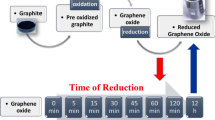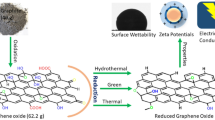Abstract
Graphene has several favourable characteristics for both current and prospective applications. However, there are some economic issues emanating from the current methods of graphene synthesis and the need for high dispersibility in most potential applications. Reduced graphene oxide (RGO) is a suitable alternative that addresses these shortfalls. The synthesis of RGO via graphene oxide (GO) is leading to a quest for effective and ‘greener’ reduction protocols that simultaneously tune physicochemical properties for specific applications. Herein the study and comparison of the effects of electrophilic (empty orbitals on boron in boric anhydride) and nucleophilic (lone pairs on nitrogen in ammonia) solutions in solvothermal reduction of GO are presented. The study provides a better interpretation of the defect intensity, from Raman spectroscopy analysis, in relation to the conductivity of RGO. The highest increase in the C/O ratio from 2.48 (GO) to 11.36 (NRGO) suggests that ammonia displays the most reductive effect. Nucleophilic attack of carbon atoms within the oxygen functionalities of GO possibly enhanced reduction. Hydrothermal, and solvothermal reduction in electrophilic and nucleophilic solutions improved conductivity by two, three and five orders of magnitude relative to pristine GO, respectively. The sheet resistance, carrier concentration, and mobility of the superior NRGO were 93 Ω cm, 3.51 × 1018 cm−3 and 0.02 cm2 V−1 s−1, respectively. The solvent properties are dynamic in both the solvothermal reduction of GO and electronic property tailoring of RGO. The current work paves the way for future, cost-effective, facile reduction and doping protocols that tailor the physicochemical properties of graphene derivatives from the solvent nature. This is a practical economic approach that solves conductivity issues of GO whilst avoiding the use of toxic chemicals and high temperatures toward effective electronic devices.








Similar content being viewed by others
Data availability
Data and sample materials are available on request.
References
R. Tarcan, M. Handrea-Dragan, O. Todor-Boer, I. Petrovai, C. Farcau, M. Rusu, A. Vulpoi, M. Todea, S. Astilean, I. Botiz, A new, fast and facile synthesis method for reduced graphene oxide in N. N-dimethylformamide. Synthetic Metals 269, 116576 (2020). https://doi.org/10.1016/j.synthmet.2020.116576
E.T. Mombeshora, A. Stark, Graphene oxide applications in biorefinery catalysis to chemical commodities: critical review, prospects and challenges. Biomass Convers. Biorefinery (2021). https://doi.org/10.1007/s13399-13021-01499-13396
S.P. Sasikala, P. Poulin, C. Aymonier, Advances in subcritical hydro-/solvothermal processing of graphene materials. Adv. Mater. 29(22), 1–32 (2017). https://doi.org/10.1002/adma.201605473
V.H. Pham, T.V. Cuong, S.H. Hur, E. Oh, E.J. Kim, E.W. Shin, J.S. Chung, Chemical functionalization of graphene sheets by solvothermal reduction of a graphene oxide suspension in N-methyl-2-pyrrolidone. J. Mater. Chem. 21(10), 3371–3377 (2011). https://doi.org/10.1039/c0jm02790a
M. Seo, D. Yoon, K.S. Hwang, J.W. Kang, J. Kim, Supercritical alcohols as solvents and reducing agents for the synthesis of reduced graphene oxide. Carbon 64, 207–218 (2013). https://doi.org/10.1016/j.carbon.2013.07.053
S. Pei, H.-M. Cheng, The reduction of graphene oxide. Carbon 50(9), 3210–3228 (2012). https://doi.org/10.1016/j.carbon.2011.11.010
T. Tene, M. Guevara, A. Valarezo, O. Salguero, F. Arias Arias, M. Arias, A. Scarcello, L.S. Caputi, C. Vacacela Gomez, Drying-time study in graphene oxide. Nanomaterials (Basel) 11(4), 1–14 (2021). https://doi.org/10.3390/nano11041035
E.T. Mombeshora, P.G. Ndungu, V.O. Nyamori, Effect of graphite/sodium nitrate ratio and reaction time on the physicochemical properties of graphene oxide. New Carbon Mater. 32(2), 174–187 (2017). https://doi.org/10.1016/s1872-5805(17)60114-8
E.T. Mombeshora, A. Stark, Understanding oxidative reaction of carbon nanoplatelets towards tailored physicochemical properties. Mater. Chem. Phys. 277, 125535 (2022). https://doi.org/10.1016/j.matchemphys.2021.125535
J.A. Quezada Renteria, C. Ruiz-Garcia, T. Sauvage, L.F. Chazaro-Ruiz, J.R. Rangel-Mendez, C.O. Ania, Photochemical and electrochemical reduction of graphene oxide thin films: tuning the nature of surface defects. Phys Chem Chem Phys 22(36), 20732–20743 (2020). https://doi.org/10.1039/d0cp02053b
H. Saleem, M. Haneef, H.Y. Abbasi, Synthesis route of reduced graphene oxide via thermal reduction of chemically exfoliated graphene oxide. Mater. Chem. Phys. 204, 1–7 (2018). https://doi.org/10.1016/j.matchemphys.2017.10.020
H.H. Huang, K.K.H. De Silva, G.R.A. Kumara, M. Yoshimura, Structural evolution of hydrothermally derived reduced graphene oxide. Sci. Rep. 8(1), 6849 (2018). https://doi.org/10.1038/s41598-018-25194-1
Moradi Kooshksara M, Mohammadi S (2021) Investigation of the in-situ solvothermal reduction of multi-layered graphene oxide in epoxy coating by acetonitrile on improving the hydrophobicity and corrosion resistance. Progress in Organic Coatings 159. doi:https://doi.org/10.1016/j.porgcoat.2021.106432
E.T. Mombeshora, P.G. Ndungu, V.O. Nyamori, The physicochemical properties and capacitive functionality of pyrrolic- and pyridinic-nitrogen, and boron-doped reduced graphene oxide. Electrochim. Acta 258, 467–476 (2017). https://doi.org/10.1016/j.electacta.2017.11.084
S. Dubin, S. Gilje, K. Wang, V.C. Tung, K. Cha, A.S. Hall, J. Farrar, R. Varshneya, Y. Yang, R.B. Kaner, A one-step, solvothermal reduction method for producing reduced graphene oxide dispersions in organic solvents. ACS Nano 4(7), 3845–3852 (2010). https://doi.org/10.1021/nn100511a
T. Shi, J. Liang, X. Li, C. Zhang, H. Yang, Improving the corrosion resistance of aluminum alloy by creating a superhydrophobic surface structure through a two-Step process of etching followed by polymer modification. Polymers (Basel) (2022). https://doi.org/10.3390/polym14214509
H.N. Tien, V.H. Luan, T.K. Lee, B.-S. Kong, J.S. Chung, E.J. Kim, S.H. Hur, Enhanced solvothermal reduction of graphene oxide in a mixed solution of sulfuric acid and organic solvent. Chem. Eng. J. 211–212, 97–103 (2012). https://doi.org/10.1016/j.cej.2012.09.046
E.T. Mombeshora, P.G. Ndungu, A.L.L. Jarvis, V.O. Nyamori, The physical and electrochemical properties of nitrogen-doped carbon nanotube- and reduced graphene oxide-titania nanocomposites. Mater. Chem. Phys. 213, 102–112 (2018). https://doi.org/10.1016/j.matchemphys.2018.03.076
S. Kim, K. Choi, S. Park, Solvothermal reduction of graphene oxide in dimethylformamide. Solid State Sci. 61, 40–43 (2016). https://doi.org/10.1016/j.solidstatesciences.2016.07.013
D.W. Chang, H.-J. Choi, I.-Y. Jeon, J.-M. Seo, L. Dai, J.-B. Baek, Solvent-free mechanochemical reduction of graphene oxide. Carbon 77, 501–507 (2014). https://doi.org/10.1016/j.carbon.2014.05.055
D. Luo, G. Zhang, J. Liu, X. Sun, Evaluation criteria for reduced graphene oxide. J. Phys. Chem. C 115(23), 11327–11335 (2011). https://doi.org/10.1021/jp110001y
S. Park, J. An, R.D. Piner, I. Jung, D. Yang, A. Velamakanni, S.T. Nguyen, R.S. Ruoff, Aqueous suspension and characterization of chemically modified graphene sheets. Chem. Mater. 20, 6592–6594 (2008). https://doi.org/10.1021/cm801932u
J. Vigneshwaran, S. Abraham, B. Muniyandi, T. Prasankumar, J.-T. Li, S. Jose, Fe2O3 decorated graphene oxide/polypyrrole matrix for high energy density flexible supercapacitor. Surf. Interfaces 27, 101572 (2021). https://doi.org/10.1016/j.surfin.2021.101572
X. Hou, P. Ren, Z. Dai, Z. Guo, Z. Zhang, A. Sun, W. He, F. Ren, Y. Jin, N–O codoped carbon nanofibers decorated with graphene for high-performance supercapacitors. Energ. Technol. 9(12), 2100743 (2021). https://doi.org/10.1002/ente.202100743
N. Huu Hieu, H. Huu Dat, L. Tran Trung Nghia, N. Minh Dat, L. Nam Phat, N. Thi Tinh, P. Tan Khang, N. Thai Hoang, M. Thanh Phong, Synthesis of nitrogen and sulfur co-doped reduced graphene oxide by hydrothermal method for fabrication of cathodes in dye-sensitized solar cells. FlatChem 31, 100318 (2022). https://doi.org/10.1016/j.flatc.2021.100318
S. Li, Z. Wang, H. Jiang, L. Zhang, J. Ren, M. Zheng, L. Dong, L. Sun, Plasma-induced highly efficient synthesis of boron doped reduced graphene oxide for supercapacitors. Chem. Commun. 52(73), 10988–10991 (2016). https://doi.org/10.1039/c6cc04052g
M. Junaid, M.H.M. Khir, G. Witjaksono, N. Tansu, M.S.M. Saheed, P. Kumar, Z. Ullah, A. Yar, F. Usman, Boron-doped reduced graphene oxide with tunable bandgap and enhanced surface plasmon resonance. Molecules 25(16), 3646 (2020). https://doi.org/10.3390/molecules25163646
D.J. Morgan, Comments on the XPS analysis of carbon materials. J Carbon Res 7(3), 51 (2021). https://doi.org/10.3390/c7030051
A.J. Barlow, S. Popescu, K. Artyushkova, O. Scott, N. Sano, J. Hedley, P.J. Cumpson, Chemically specific identification of carbon in XPS imaging using Multivariate Auger Feature Imaging (MAFI). Carbon 107, 190–197 (2016). https://doi.org/10.1016/j.carbon.2016.05.073
Y.-L. Wang, M. Stanzione, H. Xia, G.G. Buonocore, E. Fortunati, S. Kaciulis, M. Lavorgna, Effect of mercapto-silanes on the functional properties of highly amorphous vinyl alcohol composites with reduced graphene oxide and cellulose nanocrystals. Compos. Sci. Technol. 200, 108458 (2020). https://doi.org/10.1016/j.compscitech.2020.108458
S. Kaciulis, A. Mezzi, P. Soltani, T. de Caro, H. Xia, Y.L. Wang, T. Zhai, M. Lavorgna, Reduction of graphene oxide by UHV annealing. Surf. Interface Anal. 50(11), 1089–1093 (2018). https://doi.org/10.1002/sia.6424
V. Ludwig, A.H. de Lima, L. Modesto-Costa, Z.M. Da Costa Ludwig, J.P.A. de Mendonça, W.G. Quirino, F. Sato, Experimental and theoretical study of solvent effect in graphene oxide. J. Mol. Liq. 342, 1–9 (2021). https://doi.org/10.1016/j.molliq.2021.117429
E.T. Mombeshora, E. Muchuweni, M.L. Davies, V.O. Nyamori, B.S. Martincigh, Metal-organic chemical vapor deposition of anatase titania on multiwalled carbon nanotubes for electrochemical capacitors. Energy Science & Engineering 10, 3493–3506 (2022). https://doi.org/10.1002/ese3.1234
Y. Shen, H.-B. Zhang, H. Zhang, W. Ren, A. Dasari, G.-S. Tang, Z.-Z. Yu, Structural evolution of functionalized graphene sheets during solvothermal reduction. Carbon 56, 132–138 (2013). https://doi.org/10.1016/j.carbon.2012.12.088
H. Wang, H. Tian, S. Wang, W. Zheng, Y. Liu, Simple and eco-friendly solvothermal synthesis of luminescent reduced graphene oxide small sheets. Mater. Lett. 78, 170–173 (2012). https://doi.org/10.1016/j.matlet.2012.03.048
M.A.M. Motchelaho, H. Xiong, M. Moyo, L.L. Jewell, N.J. Coville, Effect of acid treatment on the surface of multiwalled carbon nanotubes prepared from Fe–Co supported on CaCO3 correlation with Fischer-Tropsch catalyst activity. J. Mol. Catal. A: Chem. 335, 189–198 (2011). https://doi.org/10.1016/j.molcata.2010.11.033
X. Chen, X. Duan, Z.-H. Wen-DaOh, C.-T. Guan, Y.-A. Zhu, T.-T. Lim, Insights into nitrogen and boron-co-doped graphene toward high-performance peroxymonosulfate activation: Maneuverable N-B bonding configurations and oxidation pathways. Appl. Catal. B 253, 419–432 (2019). https://doi.org/10.1016/j.apcatb.2019.04.018
J.S. Roh, H.W. Yoon, L. Zhang, J.-Y. Kim, J. Guo, H.W. Kim, Carbon lattice structures in nitrogen-doped reduced graphene oxide: Implications for carbon-based electrical conductivity. ACS Appl. Nano Mater. 4(8), 7897–7904 (2021). https://doi.org/10.1021/acsanm.1c01228
H. Mousavi, R. Moradian, Nitrogen and boron doping effects on the electrical conductivity of graphene and nanotube. Solid State Sci. 13(8), 1459–1464 (2011). https://doi.org/10.1016/j.solidstatesciences.2011.03.008
E.T. Mombeshora, E. Muchuweni, R. Garcia-Rodriguez, M.L. Davies, V.O. Nyamori, B.S. Martincigh, A review of graphene derivative enhancers for perovskite solar cells. Nanoscale Adv. 4, 2057–2076 (2022). https://doi.org/10.1039/d1na00830g
E.T. Mombeshora, P.G. Ndungu, A.L.L. Jarvis, V.O. Nyamori, Oxygen-modified multiwalled carbon nanotubes: physicochemical properties and capacitor functionality. Int. J. Energy Res. 41(8), 1182–1201 (2017). https://doi.org/10.1002/er.3702
K. Mugadza, E.T. Mombeshora, A. Stark, P.G. Ndungu, V.O. Nyamori, Surface modifications of carbon nanotubes towards tailored electrochemical characteristics. J. Mater. Sci. Mater. Electron. 32, 27923–27936 (2021). https://doi.org/10.1007/s10854-021-07174-w
D. Mohanadas, M.A.A. Mohd Abdah, N.H.N. Azman, J. Abdullah, Y. Sulaiman, A promising negative electrode of asymmetric supercapacitor fabricated by incorporating copper-based metal-organic framework and reduced graphene oxide. Int. J. Hydrogen Energy 46(71), 35385–35396 (2021). https://doi.org/10.1016/j.ijhydene.2021.08.081
Acknowledgements
The author wishes to thank the University of KwaZulu-Natal (UKZN) and the University of Zimbabwe for providing the necessary support to this work. The author is also grateful to Annegret Stark, Bice S. Martincigh and Vincent O. Nyamori for postdoctoral mentorship, Matthew L. Davies for funding acquisition and mentorship, and James Mcgettrick for assistance in X-ray photoelectron spectroscopy analysis.
Funding
This work is based on research supported wholly by funding through the EPSRC GCRF SUNRISE project (Grant Number: EP/P032591/1) and in part, by the National Research Foundation (NRF) of South Africa (Grant Number: 116631).
Author information
Authors and Affiliations
Contributions
ETM solely contributed to the conceptualization, methodology, experimental analysis, formal analysis, validation, writing, and editing of the manuscript.
Corresponding author
Ethics declarations
Conflict of interest
The author declares that there are no competing interests.
Additional information
Publisher's Note
Springer Nature remains neutral with regard to jurisdictional claims in published maps and institutional affiliations.
Rights and permissions
Springer Nature or its licensor (e.g. a society or other partner) holds exclusive rights to this article under a publishing agreement with the author(s) or other rightsholder(s); author self-archiving of the accepted manuscript version of this article is solely governed by the terms of such publishing agreement and applicable law.
About this article
Cite this article
Mombeshora, E.T. Understanding solvothermal reductive reactions of graphene oxide in boron and ammonia solutions. J Mater Sci: Mater Electron 34, 521 (2023). https://doi.org/10.1007/s10854-023-09955-x
Received:
Accepted:
Published:
DOI: https://doi.org/10.1007/s10854-023-09955-x




